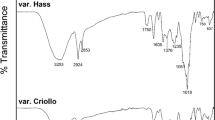Abstract
Extraction of pigments from natural sources is gaining momentum due to many biological applications. The aim of our study was to extract and to identify the pigment produced by Streptomyces species isolated from saltpan soil samples. The pigment-producing isolate was characterized by molecular taxonomy, identified as Streptomyces species, and designated as Streptomyces sp. VITVSK1. The isolate produced green color pigmentation upon solid substrate fermentation using parboiled rice as a media for 7 days at 37°C. The pigment derivative was extracted using methanol as solvent and purified by silica gel column chromatography and preparative thin layer chromatography using chloroform: methanol as solvent system. The purified compound was identified as 2,5-di-tert-butyl-1,4-benzoquinone (DTBBQ) based on similarity index with reference compounds available in the mass spectra library, NIST. Structure of the pure compound was also elucidated by 1H and 13C nuclear magnetic resonance spectra. The compound DTBBQ showed 2,2-diphenyl-1-picrylhydrazyl (DPPH) radical scavenging activity with IC50 value of 0.6 μg/mL. DTBBQ also showed antimicrobial activity with a zone of inhibition of 21 mm against Bacillus cereus. The results of the present study showed that Streptomyces sp. VITVSK1 could be a promising source for the production of biologically active quinone-based pigments.
Similar content being viewed by others
References
Abdelfattah MS, Toume K, Arai MA, Masu H, and Ishibashi M (2012) Katorazone, a new yellow pigment with a 2-azaquinone-phenylhydrazone structure produced by Streptomyces sp. Tetrahedron Lett 53, 3346–3348.
Augustine SK, Bhavsar SP, and Kapadnis BP (2005) Production of a growth dependent metabolite active against dermatophytes by Streptomyces rochei AK 39. Ind J Med Res 12, 164–170.
Bayen S, Barooah N, Sharma RJ, Sen TK, Karmakar A, and Baruah JB (2007) Synthesis, structure and electrochemical properties of 2,5-bis(alkyl/arylamino) 1, 4-benzoquinones and 2-aryl 1,4-napthoquinones. Dyes Pig 75, 770–775.
Berdy J (2005) Bioactive microbial metabolites: a personal view. J Antibiot 58, 1–26.
Buchanan GO, Regentin R, Piagentini M, Rascher A, McDaniel R, Galazzo JL et al. (2005) Production of 8-Demethylgeldanamycin and 4,5-Epoxy-8-demethylgeldanamycin from a Recombinant Strain of Streptomyces hygroscopicus. J. Nat. Prod 68, 607–610.
Charkoudian LK, Fitzgerald JT, Khosla C, and Champlin A (2010) In living color: bacterial pigments as an untapped resource in the classroom and beyond. PLoS Biology 8, doi:10.1371/journal.pbio.1000510.
Dai S, Ouyang Y, Wang G, and Li X (2011) Streptomyces autolyticus JX-47 large-insert bacterial artificial chromosome library construction and identification of clones covering geldanamycin biosynthesis gene cluster. Curr Microbiol 63, 68–74.
Duan XJ, Zhang WW, Li XM and Wang BG (2006) Evaluation of antioxidant property of extract and fractions obtained from a red alga, Polysiphonia urceolata. Food Chem 95, 37–43.
Fotso S, Maskey RP, Grun-Wollny I, Schulz KP, Munk M, and Laatsch H (2003) Bhimamycin A to approximately E and bhimanone: isolation, structure elucidation and biological activity of novel quinone antibiotics from a terrestrial Streptomycete. J Antibiot (Tokyo) 56, 931–941.
Gupta SP (1994) Quantitative structure activity relationship studies on anticancer drugs. Chem Rev 94, 1507–1551.
Hammond B, Kontos HA, and Hess ML (1985) Oxygen radicals in the adult respiratory distress syndrome, in myocardial ischemia, reperfusion injury and in cerebral vascular damage. Can J Physiol Pharmacol 63, 173–187.
Holder IA and Boyce ST (1994) Agar well diffusion assay testing of bacterial susceptibility to various antimicrobials in concentrations non-toxic for human cells in culture. Burns 5, 426–429.
Kharel MK, Shepherd MD, Nybo SE, Smith ML, Bosserman MA, and Rohr J (2010) Isolation of Streptomyces species from soil. Curr Protoc Microbiol 1–10. Doi: 10.1002/9780471729259.mc10e04s19.
Koyama J (2006) Anti-infective quinone derivatives of recent patents. Recent Pat Anti-Infect Drug Discov 1, 113–125.
Lee IK, Yun BS, Cho SM, Kim WG, Kim JP, Ryoo IJ et al. (1996) Betulinans A and B, two benzoquinone compounds from Lenzites betulina. J Nat Prod 59, 1090–1092.
Lisa E, Kotulak L, Petranek J, and Pospisil J (1972) Antioxidants and stabilizers-XXXII. Antioxidative properties of (2-alkoxyalkyl) hydroquinones-products of photochemical changes of benzoquinones. J Eur Polym 8, 501–510.
McErlean CS and Moody CJ (2007) First synthesis of N-(3-carboxylpropyl)-5-amino-2-hydroxy-3-tridecyl-1, 4-benzoquinone, an unusual quinine isolated from Embelia ribes. J Org Chem 72, 10298–10301.
Page RDM (1996) Tree view: An application to display phylogenetic trees on personal computers. Comput App Biosci 12, 357–358.
Saitou N and Nei M (1987) The Neighbor-joining method: A new method for reconstructing phylogenetic trees. Mol Biol Evol 4, 406–425.
Shirling EB and Gottlieb D (1966) Methods for characterization of Streptomyces species. IJSEM 16, 313–340.
Silva AJM, Netto CD, Pacienza-Lima W, Torres-Santos EC, Rossi-Bergmann B, Maurel S et al. (2009) Antitumoral, antileishmanial and antimalarial activity of pentacyclic 1,4-naphthoquinone derivatives. J Braz Chem Soc 20, 176–182.
Soliev AB, Hosokawa K, and Enomoto K (2011) Bioactive Pigments from marine bacteria: applications and physiological roles. Evid Based Complement Alternat Med 1–17. Doi:10.1155/2011/670349. Article ID 670349.
Spiteller P and Steglich W (2002) Blennione a green aminobenzoquinone derivative from Lactarius blennius. J Nat Prod 65, 725–727.
Stach JE, Maldonado LA, Ward AC, Goodfellow M, and Bull AT (2003) Bull New primers for the class Actinobacteria: application to marine and terrestrial environments. Environ Microbiol 5, 828–841.
Thomson RH (1997) In Naturally Occurring Quinones IV, (4th ed). Blackie academic and professional, London.
Yan GC and Chen HY (1995) Antioxidant activity of various tea extracts in relation to their antimutagenicity. J Agric Food Chem 43, 27–32.
Zhang H, Zhan J, Keman Su, and Zhang Y (2006) A kind of potential food additive produced by Streptomyces coelicolor: Characteristics of blue pigment and identification of a novel compound, k-actinorhodin. Food Chem 95, 186–192.
Author information
Authors and Affiliations
Corresponding author
Rights and permissions
About this article
Cite this article
Gopal, J.V., Subashini, E. & Kannabiran, K. Extraction of quinone derivative from Streptomyces sp. VITVSK1 isolated from Cheyyur saltpan, Tamilnadu, India. J Korean Soc Appl Biol Chem 56, 361–367 (2013). https://doi.org/10.1007/s13765-013-3052-6
Received:
Accepted:
Published:
Issue Date:
DOI: https://doi.org/10.1007/s13765-013-3052-6




